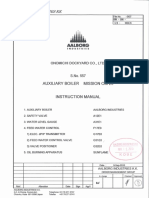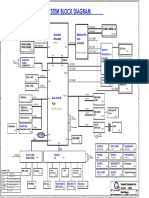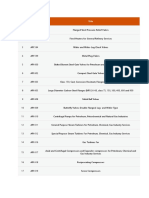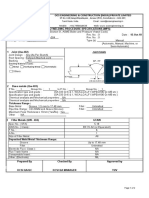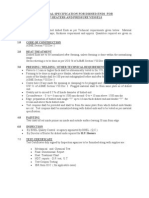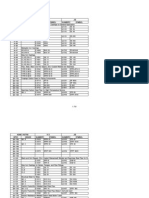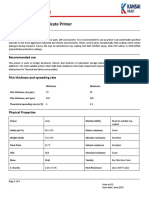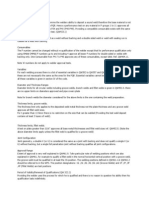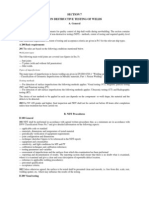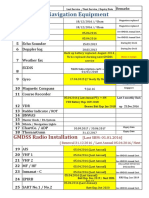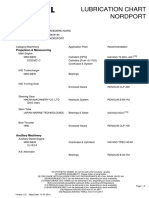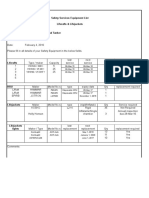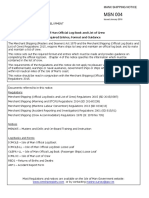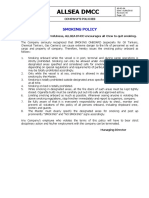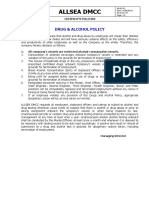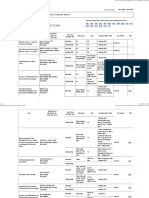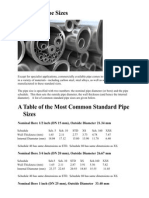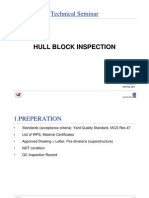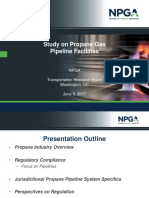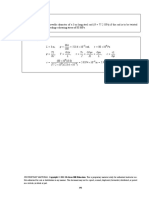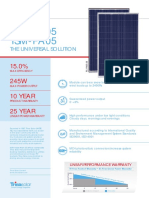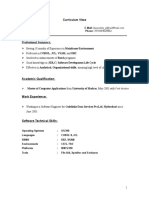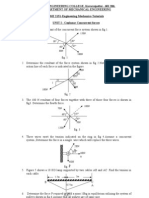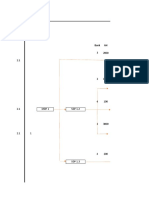NDT of Piping
NDT of Piping
Uploaded by
Vu Tung LinhCopyright:
Available Formats
NDT of Piping
NDT of Piping
Uploaded by
Vu Tung LinhCopyright
Available Formats
Share this document
Did you find this document useful?
Is this content inappropriate?
Copyright:
Available Formats
NDT of Piping
NDT of Piping
Uploaded by
Vu Tung LinhCopyright:
Available Formats
A 500 Non-destructive testing 501 In general, the welded joints including the inside wherever possible shall be visually
examined. Non-destructive tests will be required depending on the class of pipes and type of joints as hereunder indicated: Butt welded joints: for class I pipes with an outer diameter greater than 76.1 mm, 100% radiographic testing (RT) is required. for class II pipes with an outer diameter greater than 101.6 mm and for class I pipes with an outer diameter 76.1 mm, at least 10% random radiographic testing is required. More stringent requirements may be applied at the surveyors discretion depending on the kind of materials, welding procedure and controls during the fabrication. Fillet welds: for fillet welds of flange type connections in class I pipes with an outer diameter greater than 76.1 mm, 100% magnetic particle testing (MT) is required. for class II pipes with an outer diameter greater than 101.6 mm and for class I pipes with an outer diameter 76.1 mm, random magnetic particle testing at the discretion of the surveyor is required. In addition welded joints in pipes for thermal oil shall be subject to at least 10% random radiographic testing. 502 Heating coils in cargo tanks shall be subject to NDT in accordance with Table A4.
Table A4 Non-destructive testing (NDT) of heating coils Joint types Butt welds 1) Sleeve or lap type welded or brazed joints Erection welds Shop welds Erection joints Shop welded or brazed joints 10% 5% 10% 5% 10% 5% 10% 5% 10% 5% Spot-check NDT. Steam testing onboard 2)
Material in coils
Mild steel Stainless steel Cu-Ni or Al-brass Notes:
1) If automatic welding is used, the percentage may be reduced at the surveyors discretion. 2) Experience shows that pressure tests do not always reveal leaks in joints because a capillary gap can be temporarily sealed by flux residues. A recommended part of the procedure for testing a heating coil system should therefore be to apply a steam test, which will dissolve flux residues and reveal leaks.
503 An approved ultrasonic testing (UT) procedure may be accepted, at the discretion of the Society, in lieu of radiographic testing when the conditions are such that a comparable level of weld quality is assured. For non-magnetic materials dye-penetrant testing (PT) shall be used in lieu of magnetic particle examination. 504 Non-destructive testing shall be performed by operators certified in accordance with a recognized scheme, using suitable equipment and procedures. The radiographs shall be marked in such a way that their position on the pipe line may easily be located. 505 The radiographs shall be judged according to ISO 5817 "Arc-welded joints in steel - Guidance on quality levels for imperfections", and are at least to meet the requirements for quality level B for welds in class I piping and for quality level C otherwise. The results from surface examination (e.g. MT, PT) shall satisfy the requirements of level B of ISO 5817. 506 The repair of defects revealed during non-destructive testing shall be carried out according to agreement with the surveyor. All such weld repairs shall be examined using the relevant testing method.
You might also like
- Auxiliary Boiler Aalborg MISSION OM 25 Instruction ManualDocument369 pagesAuxiliary Boiler Aalborg MISSION OM 25 Instruction ManualYevgen Yushkov86% (7)
- ROSOV Manual - L & TDocument122 pagesROSOV Manual - L & TMuneeshNo ratings yet
- Electron Beam Welding Procedure Qualification Record WPQR (Qmob) #EBW 2015 01Document18 pagesElectron Beam Welding Procedure Qualification Record WPQR (Qmob) #EBW 2015 01aNKUR100% (1)
- 1.4301 Austenite Stainless SteelDocument3 pages1.4301 Austenite Stainless SteelSM Waqas ImamNo ratings yet
- 04 WPS Atp Asme 2012 (A312 304) (A312 310)Document6 pages04 WPS Atp Asme 2012 (A312 304) (A312 310)lailatul kodriNo ratings yet
- Procedure For Internal AuditDocument3 pagesProcedure For Internal AuditVu Tung Linh100% (1)
- Acer Aspire Timelinex 5820tg Quanta zr7b Rev 1a SCH PDFDocument50 pagesAcer Aspire Timelinex 5820tg Quanta zr7b Rev 1a SCH PDFSabrina Bry BuccittiNo ratings yet
- 2-Asme BPVC Section Ix-2013Document2 pages2-Asme BPVC Section Ix-2013Reda ElsawyNo ratings yet
- NDT PDFDocument13 pagesNDT PDFAaron QuinnNo ratings yet
- Sa 450/sa 450MDocument13 pagesSa 450/sa 450MSaravana VelNo ratings yet
- Koc MP 018Document17 pagesKoc MP 018Subhajit Bhattacharya100% (1)
- Material Requisition For Bolt and Nuts-Rev0Document5 pagesMaterial Requisition For Bolt and Nuts-Rev0altipatlar100% (1)
- Quality and Inspection Requirements For New and Refurbished Drilling and Well Completion Equipment Once Printed This Specification Becomes An Uncontrolled Copy of The Online VersionDocument6 pagesQuality and Inspection Requirements For New and Refurbished Drilling and Well Completion Equipment Once Printed This Specification Becomes An Uncontrolled Copy of The Online Versionislam atifNo ratings yet
- Asme Section II A-2 Sa-453 Sa-453mDocument10 pagesAsme Section II A-2 Sa-453 Sa-453mAnonymous GhPzn1xNo ratings yet
- Airvac Portable Vacuum Recovery SystemDocument8 pagesAirvac Portable Vacuum Recovery SystemEngTamerNo ratings yet
- Work Instruction FOR: Tensile TestDocument4 pagesWork Instruction FOR: Tensile TestmahendraNo ratings yet
- Qualified Welder List According To Asme IxDocument5 pagesQualified Welder List According To Asme IxAhmad Nabil ElsharkawyNo ratings yet
- Asme Code For Ultrasonic Testing The Knowledge Sinequation: Ashok J. TrivediDocument7 pagesAsme Code For Ultrasonic Testing The Knowledge Sinequation: Ashok J. TrivediMax Celis CNo ratings yet
- S/A 106 Spec Sheet A106 Pipe Specifications: ScopeDocument7 pagesS/A 106 Spec Sheet A106 Pipe Specifications: ScopeyanurarzaqaNo ratings yet
- Api StandardDocument2 pagesApi Standardkesavan g100% (1)
- OCS Prel WPS 007Document2 pagesOCS Prel WPS 007vinothNo ratings yet
- B Boehler-Fox-Cel Se en v1Document1 pageB Boehler-Fox-Cel Se en v1tacosanchezbrayanNo ratings yet
- MTC DetailsDocument2 pagesMTC DetailsHarisul IslamNo ratings yet
- Duplex Material PDFDocument4 pagesDuplex Material PDFmengelito almonteNo ratings yet
- PMS-V32-Ball Valves - FlangedDocument2 pagesPMS-V32-Ball Valves - FlangedMB Azharudeen100% (1)
- Unit-9 Visual Testing (VT) : 1. ProcedureDocument5 pagesUnit-9 Visual Testing (VT) : 1. ProcedureVivekanandan JNo ratings yet
- Modul Tambahan Kualifikasi Las (KL)Document27 pagesModul Tambahan Kualifikasi Las (KL)Nurhamsyah Susianto0% (1)
- Astm E570Document7 pagesAstm E570陳明書No ratings yet
- Testing of WeldsDocument59 pagesTesting of WeldsberhaneNo ratings yet
- A106 Seamless Carbon Steel Pipe: Hydrostatic TestingDocument7 pagesA106 Seamless Carbon Steel Pipe: Hydrostatic TestingTan Chee MingNo ratings yet
- Mds-Sparkler Filter F-304Document1 pageMds-Sparkler Filter F-304Vipul Gandhi50% (2)
- Piping Engineer B2 PDFDocument1 pagePiping Engineer B2 PDFAniz DonuTz100% (1)
- Stainless Steel Pipe SpecificationDocument3 pagesStainless Steel Pipe SpecificationBhairu BaniNo ratings yet
- 23 Astm A790 A790m-2018Document10 pages23 Astm A790 A790m-2018FYNo ratings yet
- A1X3R1 - 2d - EPI-08-WP5-TW PDFDocument10 pagesA1X3R1 - 2d - EPI-08-WP5-TW PDFJose Anisio SilvaNo ratings yet
- Specification For Seamless Copper TubeDocument9 pagesSpecification For Seamless Copper TubeingesanNo ratings yet
- Is 3589Document22 pagesIs 3589Otavio123100% (1)
- Floating Flange Rubber Expansion Joints: Series 980Document8 pagesFloating Flange Rubber Expansion Joints: Series 980Roland Bon IntudNo ratings yet
- Metalcor 1.4571 Aisi 316 TiDocument1 pageMetalcor 1.4571 Aisi 316 TirezaNo ratings yet
- Qw-483 Procedure Qualification Records (PQR: Groove Design of Test Coupon Base Metals (Qw-403) Filler Metals (Qw-404)Document2 pagesQw-483 Procedure Qualification Records (PQR: Groove Design of Test Coupon Base Metals (Qw-403) Filler Metals (Qw-404)Parminder SinghNo ratings yet
- Dished EndsDocument2 pagesDished EndsRamdoss RavindirenNo ratings yet
- Din en 10216-2Document2 pagesDin en 10216-2vishal.nitham100% (1)
- Table A3 Typical Storage and Drying Conditions For Covered Arc Welding ElectrodesDocument1 pageTable A3 Typical Storage and Drying Conditions For Covered Arc Welding Electrodesravi00098No ratings yet
- ASTM A131 Steel, Grade DDocument1 pageASTM A131 Steel, Grade DjulianmorantesNo ratings yet
- BPQ REV. 0 Interactive FormDocument2 pagesBPQ REV. 0 Interactive FormcosmicbunnyNo ratings yet
- Pitch Diameter and Ovality Gages Tapered Threads MRP-1000 Series MRP-2000 Series MRP-3000 SeriesDocument2 pagesPitch Diameter and Ovality Gages Tapered Threads MRP-1000 Series MRP-2000 Series MRP-3000 Seriessajithv78No ratings yet
- Standard Specification For Castings, Iron-Chromium, Iron-Chromium-Nickel, Corrosion Resistant, For General ApplicationDocument8 pagesStandard Specification For Castings, Iron-Chromium, Iron-Chromium-Nickel, Corrosion Resistant, For General ApplicationFayez Al-ahmadiNo ratings yet
- Spec Grade Number Symbol Number Symbol Asme (Astm) KS JISDocument50 pagesSpec Grade Number Symbol Number Symbol Asme (Astm) KS JISVinay TrivediNo ratings yet
- Ultrasonic Test of Steel Plates and Forgings: Technical Purchase Specification Acc. To DIN/EN and ASME-CodeDocument2 pagesUltrasonic Test of Steel Plates and Forgings: Technical Purchase Specification Acc. To DIN/EN and ASME-CodeKerem DemirbaşNo ratings yet
- Inspection Call FormatDocument1 pageInspection Call FormatMATHEENNo ratings yet
- Presentation Teledyne ICM NDT 2019 - DD - DIGITAL RADIOGRAPHY 1 SVDocument21 pagesPresentation Teledyne ICM NDT 2019 - DD - DIGITAL RADIOGRAPHY 1 SVdantegimenezNo ratings yet
- CCH 70-3 Specification For Inspection of Steel Castings of Hydraulic MachinesDocument81 pagesCCH 70-3 Specification For Inspection of Steel Castings of Hydraulic MachinesproyectosbogotaNo ratings yet
- Spec Sheet - Handler 187Document4 pagesSpec Sheet - Handler 187Hobart Welding ProductsNo ratings yet
- Welded Joint DesignDocument5 pagesWelded Joint Designscott2355No ratings yet
- TDS Kan Ethyl Zinc Silicate PrimerDocument3 pagesTDS Kan Ethyl Zinc Silicate PrimeroliviaNo ratings yet
- Asme Section I: Section - Iii Code ExtractionDocument3 pagesAsme Section I: Section - Iii Code ExtractionReadersmo100% (1)
- Materials WQTDocument2 pagesMaterials WQTZohaib AnserNo ratings yet
- Me Interview QuesDocument37 pagesMe Interview QuesLUCIFERBREONo ratings yet
- 163 Dimensions of Large Male Female and Small Tongue and Groove Flange Facing Ansi b165 StandardDocument6 pages163 Dimensions of Large Male Female and Small Tongue and Groove Flange Facing Ansi b165 StandardQiuniuNo ratings yet
- Suryavelli: RTJ Groove Measurement Using Suryavelli Make Ball CaliperDocument3 pagesSuryavelli: RTJ Groove Measurement Using Suryavelli Make Ball CalipersuriyavinNo ratings yet
- NDT of WeldsDocument4 pagesNDT of WeldsVu Tung Linh100% (2)
- RP 2007-18 App.DDocument3 pagesRP 2007-18 App.DdrailotaNo ratings yet
- ClassNK - PSC Annual Report (June 2019) PDFDocument57 pagesClassNK - PSC Annual Report (June 2019) PDFVu Tung Linh100% (1)
- HT - 02 Procedure For Organisation, ResponsibilitiesDocument17 pagesHT - 02 Procedure For Organisation, ResponsibilitiesVu Tung Linh100% (1)
- Bridge Equipment Due - Jan 2017Document8 pagesBridge Equipment Due - Jan 2017Vu Tung LinhNo ratings yet
- DMLCIIDocument2 pagesDMLCIIVu Tung LinhNo ratings yet
- Guidelines Low Load HFODocument11 pagesGuidelines Low Load HFOVu Tung Linh100% (1)
- MOT-No 168 PDFDocument9 pagesMOT-No 168 PDFVu Tung LinhNo ratings yet
- PortDocument5 pagesPortVu Tung LinhNo ratings yet
- Safety EquipmentDocument10 pagesSafety EquipmentVu Tung LinhNo ratings yet
- Isle of Man Official Log Book and List of Crew Required Entries, Format and GuidanceDocument28 pagesIsle of Man Official Log Book and List of Crew Required Entries, Format and GuidanceVu Tung LinhNo ratings yet
- Procedure For CommunicationDocument2 pagesProcedure For CommunicationVu Tung Linh100% (1)
- Energy Management PolicyDocument1 pageEnergy Management PolicyVu Tung Linh100% (1)
- Underkeel Clearance PolicyDocument1 pageUnderkeel Clearance PolicyVu Tung LinhNo ratings yet
- Procedure For Crew ChangeDocument5 pagesProcedure For Crew ChangeVu Tung Linh100% (1)
- Smoking PolicyDocument1 pageSmoking PolicyVu Tung LinhNo ratings yet
- HSE PolicyDocument1 pageHSE PolicyVu Tung LinhNo ratings yet
- Checklist For Safety Management System (SMS) Manual For Initial AuditDocument9 pagesChecklist For Safety Management System (SMS) Manual For Initial AuditVu Tung Linh100% (1)
- Drug and Alcohol PolicyDocument1 pageDrug and Alcohol PolicyVu Tung LinhNo ratings yet
- IACS UR's and Panel ResponsibleDocument13 pagesIACS UR's and Panel ResponsibleVu Tung LinhNo ratings yet
- Ship SizesDocument12 pagesShip SizesVu Tung LinhNo ratings yet
- Valve MaterialsDocument9 pagesValve MaterialsVu Tung LinhNo ratings yet
- IMO International Convention Calendar - ClassNKDocument37 pagesIMO International Convention Calendar - ClassNKVu Tung LinhNo ratings yet
- NDT of WeldsDocument4 pagesNDT of WeldsVu Tung Linh100% (2)
- Standard Pipe SizesDocument5 pagesStandard Pipe SizesVu Tung LinhNo ratings yet
- Survey Procedures ManualDocument158 pagesSurvey Procedures ManualVu Tung Linh67% (3)
- Hull Block InspectionDocument19 pagesHull Block InspectionVu Tung LinhNo ratings yet
- High Rise Building Calculation SheetDocument25 pagesHigh Rise Building Calculation SheetmannshiNo ratings yet
- Study On Propane Gas Pipeline Facilities: Transportation Research Board Washington, DC June 8, 2017Document36 pagesStudy On Propane Gas Pipeline Facilities: Transportation Research Board Washington, DC June 8, 2017Anonymous jvaG8m7No ratings yet
- PROBLEM 3.31: SolutionDocument5 pagesPROBLEM 3.31: Solutionroi constantineNo ratings yet
- Swim 001 R3Document176 pagesSwim 001 R3Asim JavedNo ratings yet
- Guide Manual For JETOUR 4S Store Construction 1.0Document75 pagesGuide Manual For JETOUR 4S Store Construction 1.0alalmeeyacars100% (1)
- Tsm-Pc05 Tsm-Pa05: The Universal SolutionDocument2 pagesTsm-Pc05 Tsm-Pa05: The Universal SolutionWim VanderstraetenNo ratings yet
- Soil Improvement by GroutingDocument23 pagesSoil Improvement by GroutingJayakumar Venkataraman100% (1)
- The Entity-Relationship ModelDocument6 pagesThe Entity-Relationship ModelMiljan JeremicNo ratings yet
- Supplier Quality Manual MSP 3 ADocument18 pagesSupplier Quality Manual MSP 3 AteweweyNo ratings yet
- Ring and Full Face Dimensions 150 2500# B16.5 & 16.47 Series A&bDocument13 pagesRing and Full Face Dimensions 150 2500# B16.5 & 16.47 Series A&bGauravNo ratings yet
- Assignment 1Document2 pagesAssignment 1Gautam Kumar DeepakNo ratings yet
- Dagat-Dagatan Ave Dagat-Dagatan Ave Dagat-Dag Atan AveDocument10 pagesDagat-Dagatan Ave Dagat-Dagatan Ave Dagat-Dag Atan Aveplswork72No ratings yet
- Curriculum Vitae: P. Ajay Kumar ReddyDocument3 pagesCurriculum Vitae: P. Ajay Kumar ReddyAbhinavHarshalNo ratings yet
- NSX-S201 NSX-S202 NSX-S203 XG-S202 XG-S208: Simple ManualDocument14 pagesNSX-S201 NSX-S202 NSX-S203 XG-S202 XG-S208: Simple ManualMoacir JoséNo ratings yet
- Extra WorksDocument4 pagesExtra WorksNuwan AththanayakaNo ratings yet
- Best Practice Catalogue For HydropowerDocument331 pagesBest Practice Catalogue For HydropowerManoj SunchauriNo ratings yet
- Me 2151 e MechDocument22 pagesMe 2151 e Mechkalirajgurusamy33% (3)
- HLS2000 enDocument14 pagesHLS2000 enJoão PedroNo ratings yet
- Twido TWDLCAE40DRFDocument11 pagesTwido TWDLCAE40DRFErika BecerraNo ratings yet
- Tech Note 112 Vibration Severity Level ISO 10816-1Document1 pageTech Note 112 Vibration Severity Level ISO 10816-1Joe SmithNo ratings yet
- (Student) T2 PScrewDocument10 pages(Student) T2 PScrewZAMEER AKRAM ABDUL WAHABNo ratings yet
- Rectifier Gombel22Document19 pagesRectifier Gombel22Benny S PutraNo ratings yet
- OS XP Install GuideDocument19 pagesOS XP Install GuideLznh EmtiroNo ratings yet
- Report On Voltage DoublerDocument19 pagesReport On Voltage DoublerpavanNo ratings yet
- Understanding Accuracy Specifications For Digital Pressure Sensors RDG Vs FSDocument2 pagesUnderstanding Accuracy Specifications For Digital Pressure Sensors RDG Vs FSarunradNo ratings yet
- Engines CFM Linea BDocument9 pagesEngines CFM Linea BJuan Guillermo Correa PosadaNo ratings yet
- NEMA-CSA-UL-50 ComparisonDocument3 pagesNEMA-CSA-UL-50 ComparisonAdam BehielsNo ratings yet
- ASKODocument44 pagesASKOlaura100% (1)
